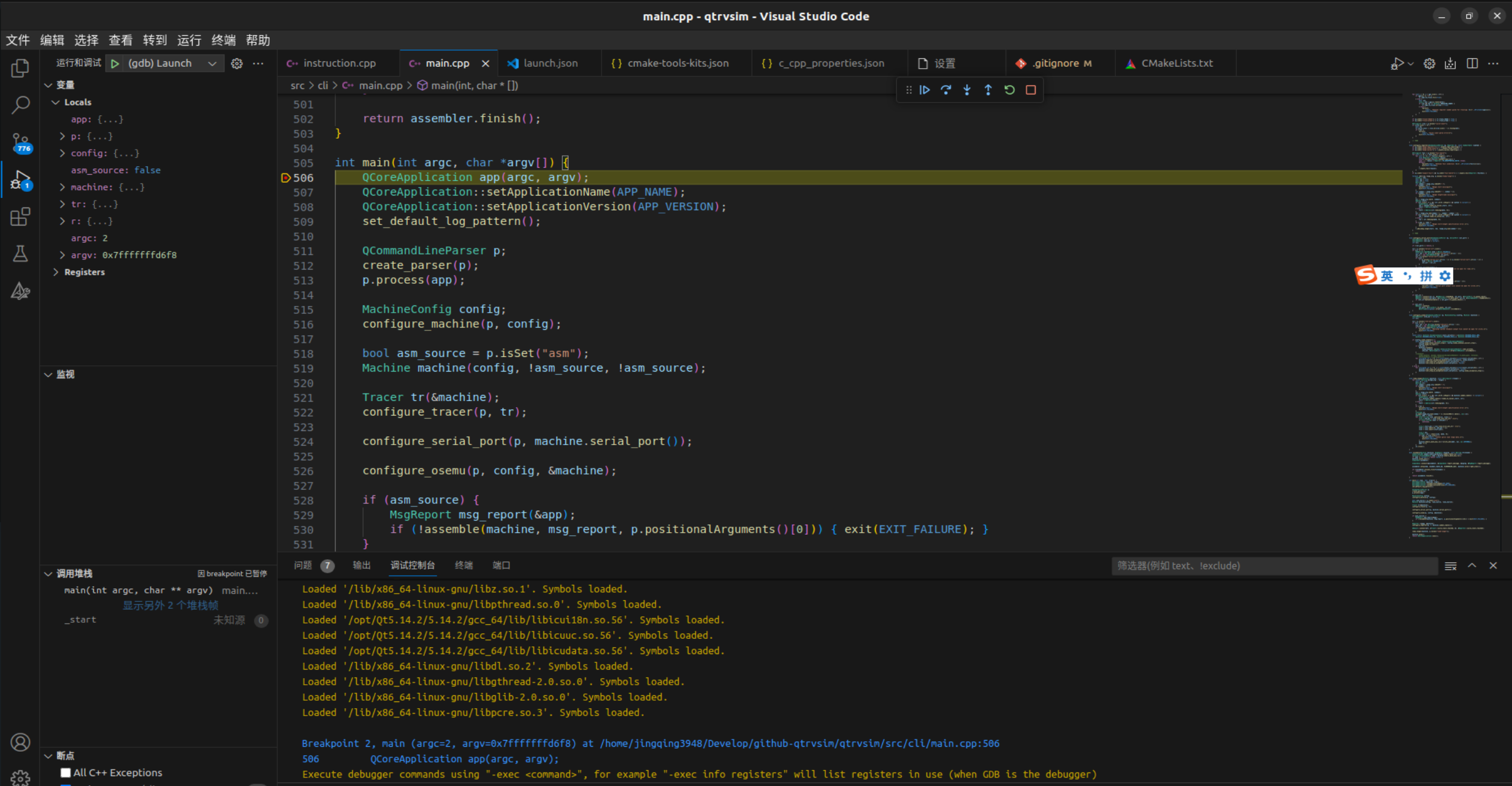继上一篇文章简单代码分析后,本文主要调研如何实现对指令的解析运行。
调试配置
使用 gdb 工具跟踪调试运行。

c_cpp_properties.json 项目配置:
{"name": "QtRvSim","includePath": ["${workspaceFolder}/**"],"defines": [],"compilerPath": "/usr/bin/clang","cStandard": "c11","cppStandard": "c++17","intelliSenseMode": "gcc-x64","configurationProvider": "ms-vscode.cmake-tools"}
launch.json:
{// 使用 IntelliSense 了解相关属性。 // 悬停以查看现有属性的描述。` // 欲了解更多信息,请访问: https://go.microsoft.com/fwlink/?linkid=830387"version": "0.2.0","configurations": [{"name": "(gdb) Launch","type": "cppdbg","request": "launch",// "program": "${fileDirname}/${fileBasenameNoExtension}","program": "${command:cmake.launchTargetPath}","args": ["/home/jingqing3948/Develop/qtrvsim-test/sum2vars-riscv"],"stopAtEntry": false,"cwd": "${workspaceFolder}","environment": [{"name": "PATH","value":"${env:PATH):${command:cmake.getLaunchTargetDirectory]"}],"externalConsole": true,"MIMode": "gdb","setupCommands": [{"description": "Enable pretty-printing for gdb","text": "-enable-pretty-printing","ignoreFailures": true}],//"preLaunchTask": "Tutorial", "miDebuggerPath": "/usr/bin/gdb"}]
}
程序解析流程
由于我的毕设任务主要是实现 F 扩展,因此我集中精力于对于指令集的解码、执行、写回过程,对于取指过程不同扩展区别不大暂不过多关注。
程序执行流程跟踪分析:
//main.cppint main(int argc, char *argv[]) {//省略一系列预配置,在 machine.play() 函数中执行程序machine.play();}
void Machine::play() {//set status//start execute each instructionsstep_internal(true);
}void Machine::step_internal(bool skip_break) {//set statustry {QTime start_time = QTime::currentTime();do {//execute one step cr->step(skip_break);} while (time_chunk != 0 && stat == ST_BUSY && !skip_break&& start_time.msecsTo(QTime::currentTime()) < (int)time_chunk);} catch (SimulatorException &e) {//set trapped status}if (regs->read_pc() >= program_end) {//set exit status} else {//set status as the previous status}
}
//core.cpp//step(): wrapper of do_step() function
void Core::step(bool skip_break) {//pcstate.cycle_count++;do_step(skip_break);emit step_done(state);
}void CoreSingle::do_step(bool skip_break) {Pipeline &p = state.pipeline;p.fetch = fetch(pc_if, skip_break);p.decode = decode(p.fetch.final);p.execute = execute(p.decode.final);p.memory = memory(p.execute.final);p.writeback = writeback(p.memory.final);regs->write_pc(mem_wb.computed_next_inst_addr);if (mem_wb.excause != EXCAUSE_NONE) {handle_exception(mem_wb.excause, mem_wb.inst, mem_wb.inst_addr, regs->read_pc(), prev_inst_addr,mem_wb.mem_addr);return;}prev_inst_addr = mem_wb.inst_addr;
}由此可见,对于F扩展的实现,除去新硬件的实现,主要需要补充的就是 Pipeline.decode() , Pipeline.execute() , Pipeline.memory() , Pipeline.writeback() 以上内容。
首先我需要先实现 F 指令集的 decode。单条指令解码由
//core.cppDecodeState Core::decode(const FetchInterstage &dt) {InstructionFlags flags;bool w_operation = this->xlen != Xlen::_64;AluCombinedOp alu_op {};AccessControl mem_ctl;ExceptionCause excause = dt.excause;// decode后把结果存在flags alu_op mem_ctl结构体里,也就是说指令解码具体实现由 instructions.cpp 的 flags_alu_op_mem_ctl 函数实现dt.inst.flags_alu_op_mem_ctl(flags, alu_op, mem_ctl);//flags结构体通过位域操作识别rs rd op等信息,并返回
}
//instructions.cppvoid Instruction::flags_alu_op_mem_ctl(InstructionFlags &flags,AluCombinedOp &alu_op,AccessControl &mem_ctl) const {//通过 InstructionMapFind 函数查找指令表const struct InstructionMap &im = InstructionMapFind(dt);flags = (enum InstructionFlags)im.flags;alu_op = im.alu;mem_ctl = im.mem_ctl;
}static inline const struct InstructionMap &InstructionMapFind(uint32_t code) {const struct InstructionMap *im = &C_inst_map[instruction_map_opcode_field.decode(code)];//递归解码,和指令集在程序中的存储方式有关while (im->subclass != nullptr) {im = &im->subclass[im->subfield.decode(code)];}if ((code ^ im->code) & im->mask) {return C_inst_unknown;}return *im;
}
也就是说对于一条指令,首先需要根据 instruction_map_opcode_field.decode(code) 判断其操作码类型,然后用对应操作码的解码表 C_inst_map 元素进行解码。并且解码是递归进行的,因为解码表的存储方式是递归存储(先大类后小类,比如 I_inst_map 下的 load 指令全部属于 LOAD_map ,包括 lb lh lw 等。)
C_inst_map 解码表目前只包含了 i 扩展的指令集,对于 F 扩展实现从 C_inst_map 开始参照 I 扩展逐层实现。
static const struct InstructionMap C_inst_map[] = {IM_UNKNOWN,IM_UNKNOWN,IM_UNKNOWN,{"i", IT_UNKNOWN, NOALU, NOMEM, I_inst_map, {}, 0x3, 0x3, { .subfield = {5, 2} }, nullptr},
};static const struct InstructionMap I_inst_map[] = {{"load", IT_I, NOALU, NOMEM, LOAD_map, {}, 0x03, 0x7f, { .subfield = {3, 12} }, nullptr}, // LOADIM_UNKNOWN, // LOAD-FPIM_UNKNOWN, // custom-0{"misc-mem", IT_I, NOALU, NOMEM, MISC_MEM_map, {}, 0x0f, 0x7f, { .subfield = {3, 12} }, nullptr}, // MISC-MEM{"op-imm", IT_I, NOALU, NOMEM, OP_IMM_map, {}, 0x13, 0x7f, { .subfield = {3, 12} }, nullptr}, // OP-IMM{"auipc", IT_U, { .alu_op=AluOp::ADD }, NOMEM, nullptr, {"d", "u"}, 0x17, 0x7f, { .flags = IMF_SUPPORTED | IMF_ALUSRC | IMF_REGWRITE | IMF_PC_TO_ALU }, nullptr}, // AUIPC{"op-imm-32", IT_I, NOALU, NOMEM, OP_IMM_32_map, {}, 0x1b, 0x7f, { .subfield = {3, 12} }, nullptr}, // OP-IMM-32 IM_UNKNOWN, // OP-IMM-32IM_UNKNOWN, // 48b{"store", IT_I, NOALU, NOMEM, STORE_map, {}, 0x23, 0x7f, { .subfield = {3, 12} }, nullptr}, // STOREIM_UNKNOWN, // STORE-FPIM_UNKNOWN, // custom-1{"amo", IT_R, NOALU, NOMEM, AMO_map, {}, 0x2f, 0x7f, { .subfield = {3, 12} }, nullptr}, // OP-32{"op", IT_R, NOALU, NOMEM, OP_map, {}, 0x33, 0x7f, { .subfield = {1, 25} }, nullptr}, // OP{"lui", IT_U, { .alu_op=AluOp::ADD }, NOMEM, nullptr, {"d", "u"}, 0x37, 0x7f, { .flags = IMF_SUPPORTED | IMF_ALUSRC | IMF_REGWRITE }, nullptr}, // LUI{"op-32", IT_R, NOALU, NOMEM, OP_32_map, {}, 0x3b, 0x7f, { .subfield = {1, 25} }, nullptr}, // OP-32IM_UNKNOWN, // 64bIM_UNKNOWN, // MADDIM_UNKNOWN, // MSUBIM_UNKNOWN, // NMSUBIM_UNKNOWN, // NMADDIM_UNKNOWN, // OP-FPIM_UNKNOWN, // reservedIM_UNKNOWN, // custom-2/rv128IM_UNKNOWN, // 48b{"branch", IT_B, NOALU, NOMEM, BRANCH_map, {}, 0x63, 0x7f, { .subfield = {3, 12} }, nullptr}, // BRANCH{"jalr", IT_I, { .alu_op=AluOp::ADD }, NOMEM, nullptr, {"d", "o(s)"}, 0x67, 0x7f, { .flags =
IMF_SUPPORTED | IMF_REGWRITE | IMF_BRANCH_JALR | IMF_ALUSRC | IMF_ALU_REQ_RS }, inst_aliases_jalr}, // JALRIM_UNKNOWN, // reserved{"jal", IT_J, { .alu_op=AluOp::ADD }, NOMEM, nullptr, {"d", "a"}, 0x6f, 0x7f, { .flags =
IMF_SUPPORTED |
IMF_REGWRITE | IMF_JUMP | IMF_PC_TO_ALU | IMF_ALUSRC }, inst_aliases_jal}, // JAL{"system", IT_I, NOALU, NOMEM, SYSTEM_map, {}, 0x73, 0x7f, { .subfield = {3, 12} }, nullptr}, // SYSTEMIM_UNKNOWN, // reservedIM_UNKNOWN, // custom-3/rv128IM_UNKNOWN, // >= 80b
};
下一步目标:从最基础的 F load, F store 指令开始实现。先达成能成功识别指令的目标。

)



)







-----CityscapesScripts生成自己的标签)

)



